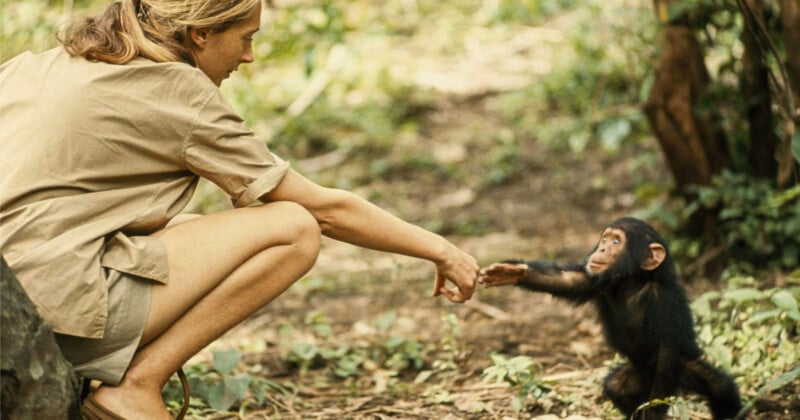Iconic Photo of Chimp Reaching Out to a Human Changed Our View of Nature

An iconic photo of primatologist Jane Goodall opposite a tiny chimpanzee with an outstretched hand changed the course of science.
Goodall’s husband Hugo van Lawick captured the photo in 1964 in Tanzania. It went on to become one of the most recognizable nature photos of all time.
What the photo communicates best is Goodall’s fresh approach to studying primates. Challenging the scientific norm at that time, Goodall defied convention by naming the chimps rather than giving them numbers.
The particular chimp in the photo was an infant called Flint. Flint is seen stretching his arm out to Goodall who is crouched on the floor of Gombe Stream National Park.
The Photo
The photo was shot on an analog camera meaning the photo was not seen by anyone for months after it was taken.
“It was a couple of months or more before there was a safe way to send exposed rolls to the [National] Geographic for processing, and then another wait while they sent the prints back to Kigoma,” Goodall tells the BBC.
“When I saw it, though I did not realise it would become iconic, it did make me think of Michelangelo’s painting of God reaching out to Man.”
The photo was first published in National Geographic magazine in December 1965 but did not make the front cover, another of van Lawick’s image did. Later that year, Nat Geo would release Miss Goodall and the Wild Chimpanzees, the first in a series of documentaries exploring Goodall’s research.
Changing Perceptions
The work that Goodall and van Lawick did together, including another documentary film entitled People of the Forest: The Chimps of Gombe, did away with outdated ideas that humans were the only intelligent beings.
“[It] forced science to abandon the idea that humans were the only sentient beings with personalities, minds, and emotions,” Goodall tells the BBC.
“Thus [this image] opened up a whole new way of understanding who animals are and showed that we humans are a part of and not separated from the rest of the animal kingdom.”
For example, Goodall noticed that chimpanzees were using tough grass to catch termites by sticking the makeshift tool into the ground and scooping the insects up to eat them. Before her discovery, this type of ingenious behavior was believed to be exclusive to humans.
The director of science at WWF, a conservation charity, calls Goodall a “trailblazer” and says that the photo highlights the importance of women in the scientific research community.
“This photo reminded us that for much of this work, there’s no alternative to being in the field. A lot of studies were in zoos or safari parks — you need to get in the field to really understand the natural behaviour,” he tells the BBC.
“And you have to do that for the long-term, you can’t just nip in for a couple of weeks. She reinforced that.”
While the powerful photo is an important milestone, the Jane Goodall Institute notes that “physical contact with wild animals is no longer deemed appropriate.”
Image credits: Hugo van Lawick.